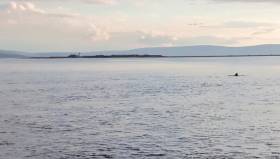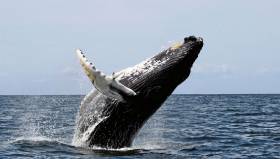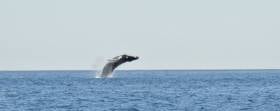Displaying items by tag: Humpback Whale
A humpback whale caught in fishing ropes off the coast of Cornwall in south-west England has been saved thanks to the efforts of local rescuers.
According to Marine Industry News, the whale known locally as “Ivy” became entangled in Mounts Bay on Easter Sunday (31 March) and was soon spotted in distress by both fishing crews and a wildlife-watching tour.
Conditions at sea were choppy at the time, meaning these onlookers could not intervene.
But in the afternoon Penlee RNLI’s volunteer lifeboat crew came to the rescue, cutting the whale free from their inshore lifeboat.
Hannah Wilson, co-owner of tour group Marine Discovery Penzance said: “It’s incredible what the guy at the helm achieved because it was properly rough.”
Marine Industry News has more on the story HERE.
Humpback Whale "Hookie" Tracked from Ireland to Bermuda to Newfoundland
A Bermudan whale researcher has confirmed that a humpback photographed in Bermudan waters is “Hookie”, which has been spotted in Irish waters.
As The Royal Gazette reports, Andrew Stevenson of Whales Bermuda said this was not only the first match of a Bermuda whale to Ireland.
The Bermudan English language publication also quotes him as stating this is “also the first match between north America and the British isles”. [sic]
Humpback whales can be identified by the pattern on their flukes — the double lobes of the animal’s tails.
Whales Bermuda set up a programme in 2007 to document whales on their migratory route past the island to the Caribbean.
“Hookie”, a male humpback, was recorded in Irish waters back in January and February 2010, and was photographed off Bermuda in 2015 by Whales Bermuda crew member Camilla Stringer.
He was sighted in June and July 2013 off the French territory islands of St Pierre et Miquelon, just off Newfoundland, Canada, and visited Trinity in Newfoundland “numerous times in 2018 and 2021”, Mr Stevenson said.
Analysis of the signature pattern has now revealed that the Bermuda whale, No 1450, was the same animal as the Ireland sighting of Hookie, Stevenson has said.
He said it is believed that Irish and British Isles humpback whales migrate to Cabo Verde in the eastern north Atlantic.
“But Hookie shows us that the more we know, the more we don't know.”
He thanked Ms Stringer for the original Bermuda identification, along with Padraig Whooley of the Irish Whale and Dolphin Group, touring company Sea of Whales Adventures based in Newfoundland, and Roger Etcheberry and Joel Detcheverry in St Pierre et Miquelon.
Read The Royal Gazette report here
The Irish Whale and Dolphin Group’s (IWDG) documentary on the trail of the humpback whale is to be screened in Kilnaboy, Co Clare today (Thur Apr 6).
The documentary “Ireland to Iceland – On The Trail Of The Humpback Whale” will be shown at the X-PO in Kilnaboy at 8 pm.
As The Clare Herald reports, the IWDG embarked on the unique research expedition in 2018.
“During the month-long navigation of Iceland’s coast, a revolving crew of volunteers visited remote coastal communities,” the newspaper says.
“They documented humpback whales in abundance, as well as recording many other species, including Blue whales and the critically endangered White-beaked dolphin,” it says.
The documentary of the voyage was shot by award-winning filmmaker Tony Whelan.
The screening will be followed by a question and answer session with Whelan, the IWDG chief science officer, Dr Simon Berrow, and expedition team members.
Admission is free, and donations to the IWDG are welcome.
Read The Clare Herald report here
Humpback Whale 'Hooky' Links Ireland and Canada
A humpback whale seen in Irish waters in January of 2010 and not reported again for thirteen years has been spotted off Newfoundland.
Sighted on January 17, 2010, inshore off Hook Head, County Waterford, by Irish Whale and Dolphin Group members, a biopsy obtained under a National Parks and Wildlife Service licence confirmed it as a young sub-adult male and a new humpback in Irish waters. It was added to the IWDG’s Irish Humpback Whale Catalogue as #HBIRL11.
“As with all humpbacks photographed in Irish waters, images of it were shared with IWDG partners ‘Allied Whale’ at the College of the Atlantic, Bar Harbor, Maine, USA, who manages the North Atlantic Humpback Whale Catalogue and have a database of 11,000+ individual humpbacks,” according to the IWDG.
It had remained adjacent to Hook Head Peninsula until February 28, 2010, and was regularly observed feeding on sprat and herring, often in the same area as fin whales and short-beaked common dolphins.
For the past 13 years, ‘Hooky’ as he was colloquially dubbed has not been recorded in Irish waters, but Allied Whale has now told IWDG it was seen off Newfoundland in 2018 and 2021.
“This is an important development, the first re-sighting between Ireland/British Isles and the western North Atlantic feeding grounds,” said Padraig Whooley, IWDG Sightings Officer. “The fact that this whale has been recorded in two known feeding areas, Newfoundland (Summer) and Irish South coast (Winter), is noteworthy.”
New Humpback Whale ‘Orion’ Sighted off Donegal
A new individual Humpback Whale, nicknamed ‘Orion’, has been sighted for the first time in Irish waters, approximately 60 kilometres north-northwest of Malin Head, Co Donegal.
The humpback whale was sighted onboard the Marine Institute’s RV Celtic Explorer as part of the annual Western European Shelf Pelagic Acoustic (WESPAS) survey. The humpback whale was sighted at 9.30 am on Friday 9th July 2021 by Dr Justin Judge, a Marine Mammal Observer who was on board the RV Celtic Explorer on behalf of the Irish Whale and Dolphin Group (IWDG). The IWDG confirmed the humpback whale is a new individual, previously unrecorded in Irish waters in the IWDG catalogue and has been given the Catalogue Number HBIRL111.
“This is a dream sighting for a Marine Mammal Observer,” Dr Justin Judge said. “The individual humpback whale ‘Orion’ has been named after the Greek mythological hunter, since the whale was moving with the fish stocks for food. It is also my son’s middle name so fitting on both fronts. There was a lot of feeding action from a multitude of cetacean species that day, including Bottlenose, Common, Risso’s and White-Sided dolphins, grey seals and Minke whales.”
 The Humpback Whale named Orion was spotted approximately 60 kilometres north-northwest of Malin Head, Co Donegal Photo: Dr Justin Judge, IWDG
The Humpback Whale named Orion was spotted approximately 60 kilometres north-northwest of Malin Head, Co Donegal Photo: Dr Justin Judge, IWDG
Humpback whales grow up to 14 to 17 metres long, and are predominantly black in colour with long white flippers and often white patches on the underside (ventral surface). When a humpback whale raises its tail or fluke, it provides an opportunity to photograph its underside. The pattern on the underside is unique to that individual whale, and these photographs are used to identify it. To date, the Irish Whale and Dolphin Group has documented 112 individual humpback whales in Irish waters since 1999, many of which are recorded year after year.
“Observing any apex predator in its natural environment is exciting but a new humpback whale for Irish waters, this is special,” WESPAS Survey scientist, Ciaran O’Donnell of the Marine Institute said. “Irish waters support a diverse range of marine life, and our annual acoustic survey programme not only monitors the health of our pelagic fish stocks, but also provides data to researchers on the overall health of the wider ecosystem. Observing and understanding our ocean, is essential for protecting and managing our marine ecosystems for the future.”
The Marine Institute’s WESPAS survey is carried out annually, and surveys shelf seas from France northwards to Scotland, and west of Ireland. WESPAS is the largest single vessel survey of its kind in the Northeast Atlantic, covering upwards of 60,000 nmi2 (nautical miles) every summer. The survey is funded through the European Maritime Fisheries and Aquaculture Fund under the Data Collection Programme which is run by the Marine Institute. Scientists collect acoustic and biological data on herring, boarfish and horse mackerel, which is used to provide an independent measure of these fish stocks in Irish waters. Scientists also monitor the physical and chemical properties of the seawater, plankton, sea birds and marine mammals during this survey.
Humpback whales are a migratory species. They can be seen in Irish waters throughout the year, but the most frequent sightings occur in spring through to early winter when they visit seasonal feeding grounds. Irish waters are an ideal feeding area for humpback whales, as it is midway on their migration across the Atlantic between Western Africa and Northern Scandinavia. Images of individual humpback whales can be used to track their local short range movements as well as their international movements along migration routes and ultimately their breeding ground.
Galway’s Dolphin Nimmo Returns To City Waters
#MarineWildlife - Galway residents have a great opportunity to see a wild dolphin close to the city centre with the return of regular visitor to the Nimmo’s Pier area this week.
Nicknamed Nimmo, the solitary bottlenose dolphin was first sighted in the city in April 2015 and since then has become an annual fixture, appearing and staying longer each time.
The Irish Whale and Dolphin Group (IWDG) suggests this is a sign that the area around Galway city is now a “more important core feeding habitat for Nimmo”.
In other news, the IWDG’s research vessel Celtic Mist will embark on a series of week-long surveys this summer in search of humpback whales.
IWDG members are invited to join any of the nine legs, the first of which sets sail from 9-15 June (weather permitting) between Cork and Dingle/Fenit.
For details on how to book a place on any of these voyages and for further information, contact [email protected].
Norwegians Free Humpback Whale From Internet Cable
#MarineWildlife - A small Norwegian community in the Arctic Circle recently had a whale of a problem with their internet connection - literally.
As New Scientist reports, a subsea internet cable in the Kaldfjorden north of Tromsø which should have been 170m below the surface broke loose from the fjord bed and entangled one of its many humpback whale visitors for more than a day.
Believing at first that the marine giant was caught in fishing gear, rescuers discovered after finally freeing the whale that it had been caught in a data cable - hence the affectionate nickname ‘Hacker’.
New Scientist has more in the story HERE.
Baltimore Sea Safari in West Cork have posted this photo of a Humpback Whale breaching off the West Cork coast.
Whale Sightings Boost In Sunny South East
#MarineWildlife - Whale sightings are on the increase in the South East this week as the season tapers off, according to the Irish Whale and Dolphin Group (IWDG).
"As large whales don't keep to our calendar year, this annual south east flurry of large whale sightings represents the tail-end our our large whale season," says the IWDG's sightings officer Pádraig Whooley.
"And what a season it has been, especially for the humpback whale, which have enjoyed a record year both in terms of frequency of sightings since they first appeared in early May off the Slea Head Peninsula."
The latest spots were made both on land – by Andrew Malcolm and Ann Trimble from Ardmore Co in Waterford at the weekend – and on a whale-watching trip with Martin Colfer's South Coast Charter Angling, recording a humpback whale and more than five fin whales between them.
And there might still be time to head down to the Sunny South East to catch a glimpse of these ocean giants before they depart for the spring.
Humpback Whale Photobombs Irish Holidaymakers In Australia
#MarineWildlife - A Dublin couple on a whale-watching tour off Queensland recently had to content with an attention-seeking humpback whale as they posed for a photo, as the Irish Post reports.
But the holidaying pair Declan and Mandy O’Donoghue seemed happy enough to share the spotlight with the marine giant as it slapped a fin on the waves behind them.































































